Electric vehicles (EVs) are zooming ahead in popularity, not just because they’re cool and tech-savvy, but because they promise a cleaner, greener future. But hold up—did you know that this surge in EVs might be pushing our power grid to its limits? Let’s break down how these electric wonders are changing the game for energy demand and what’s being done to keep the lights on.
Rising Popularity of EVs

The International Energy Agency (IEA) reports that the number of electric cars on the road surpassed 10 million in 2020, showing a 43% increase from the previous year.
Increased Energy Demand

EVs require significant amounts of electricity to charge. According to the U.S. Department of Energy, a typical EV consumes about 30 kilowatt-hours (kWh) to travel 100 miles. With millions of EVs on the road, this significantly increases overall electricity demand.
Grid Strain and Peak Load

The power grid experiences strain during peak load times, typically in the evenings when people return home and plug in their vehicles.
A study by the California Energy Commission highlights that by 2030, peak electricity demand could increase by up to 5,500 megawatts due to EV charging, which is equivalent to adding the power demand of approximately 1.25 million homes.
Smart Charging Solutions

To mitigate the impact, smart charging solutions are being developed. These systems optimize charging times, spreading the load more evenly and reducing peak demand.
A report from the Rocky Mountain Institute indicates that smart charging can reduce the need for additional power generation capacity by up to 70%.
Vehicle-to-Grid Technology

Innovative technologies like vehicle-to-grid (V2G) allow EVs to discharge energy back into the grid. This can help balance supply and demand, making the grid more resilient.
According to the University of Delaware, a fleet of 100 V2G-capable vehicles could provide about 1 megawatt of power to the grid.
Renewable Energy Integration

The integration of renewable energy sources is essential to support the growing demand. Solar and wind power can provide the necessary energy to charge EVs sustainably.
The National Renewable Energy Laboratory (NREL) projects that by 2050, renewables could provide up to 80% of the U.S. electricity supply, which will be crucial for meeting the increased demand from EVs.
Battery Storage Systems

Advancements in battery storage technology are crucial. These systems store excess energy generated during low-demand periods and release it during peak times, helping to stabilize the grid.
The U.S. Energy Information Administration (EIA) notes that battery storage capacity in the U.S. has more than doubled since 2019.
Policy and Infrastructure

Government policies and infrastructure development play a significant role. Investment in charging infrastructure and supportive regulations can facilitate a smoother transition to a high-EV future.
The Biden Administration has committed to installing 500,000 EV charging stations by 2030.
Utility Companies’ Role

Utility companies are adapting to the changing landscape. Many are offering incentives for off-peak charging and investing in grid modernization to handle the increased load.
Pacific Gas and Electric Company (PG&E) has launched programs offering reduced rates for EV owners who charge their vehicles during off-peak hours.
Environmental Impact

While EVs reduce greenhouse gas emissions, the source of the electricity matters. Ensuring that the additional power demand is met with renewable sources is critical for maximizing environmental benefits.
EVs charged on a renewable-heavy grid can significantly cut greenhouse gas emissions compared to traditional gasoline vehicles, according to the Union of Concerned Scientists. This shift to renewables for EV charging means cleaner air and a substantial reduction in our carbon footprint.
Consumer Behavior

Educating consumers about the benefits of off-peak charging can help distribute the demand more evenly. Incentives and programs can encourage more sustainable charging habits.
A survey by the Electric Power Research Institute (EPRI) found that 40% of EV owners are willing to adjust their charging times to off-peak hours if incentivized.
Economic Considerations

The increased demand for electricity can drive up costs. However, with proper management and investment, the economic benefits of widespread EV adoption can outweigh the challenges.
A report from Bloomberg New Energy Finance (BNEF) projects that by 2040, EVs could displace 7.3 million barrels of transportation fuel per day, significantly impacting the oil market and economy.
Grid Modernization

Modernizing the grid is essential for handling the increased load. Smart grids, advanced metering infrastructure, and enhanced grid management systems can improve efficiency and reliability.
The U.S. Department of Energy is investing billions in grid modernization projects across the country.
Research and Development

Ongoing research and development are vital. Innovations in charging technology, grid management, and renewable energy integration will support the transition to an EV-dominated future.
The Advanced Research Projects Agency-Energy (ARPA-E) is funding numerous projects aimed at improving grid resilience and EV integration.
Global Trends

The impact of EVs on the power grid is a global issue. Countries around the world are facing similar challenges and exploring solutions to ensure a stable and sustainable energy future.
For example, Norway, where EVs account for over 50% of new car sales, is investing heavily in grid upgrades and renewable energy sources.
Final Thoughts

The rise of electric vehicles presents both challenges and opportunities for the power grid. With smart planning, investment in technology, and supportive policies, renewable sources can handle peak demand, paving the way for a sustainable energy future. Balancing innovation with infrastructure development is key to making this transition successful.
Featured Image Credit: Shutterstock / Scharfsinn.
For transparency, this content was partly developed with AI assistance and carefully curated by an experienced editor to be informative and ensure accuracy.





